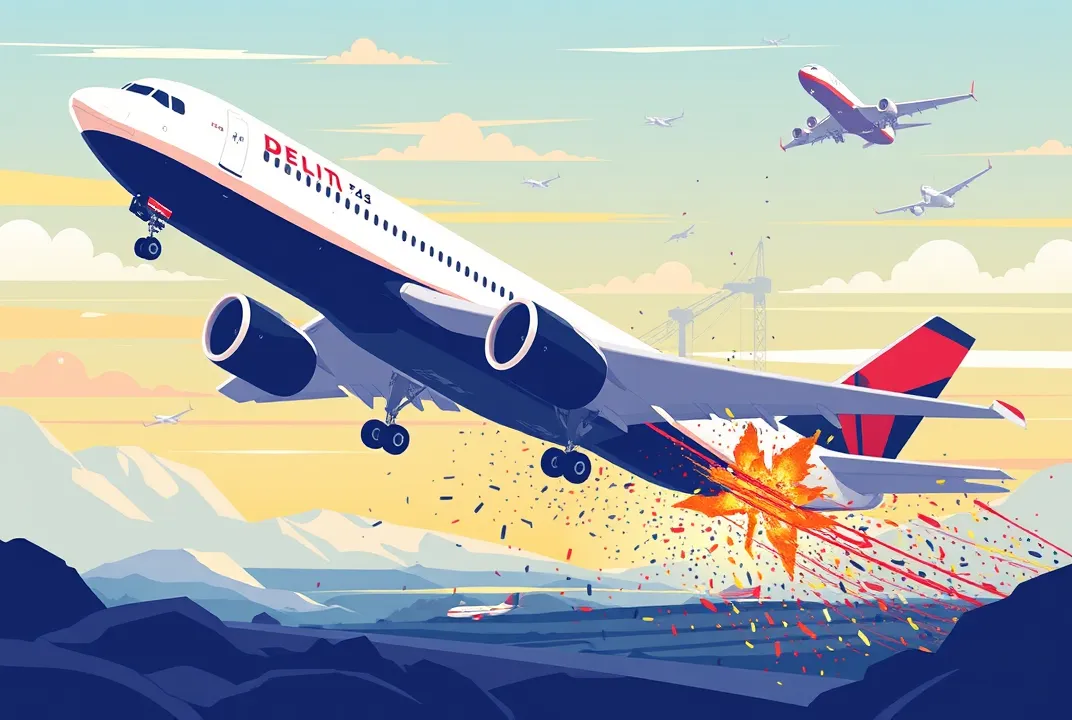Introduction: A Day of Tragedy and Reflection
It was a clear blue sky on a typical day when Delta Airlines Flight 215 took off from Atlanta, bound for Chicago. The passengers settled into their seats, excited for their journeys—some for business, others for vacation. Little did they know, the tranquility of that flight would soon be shattered, leading to an unprecedented investigation into the causes of the crash that changed the aviation landscape forever.
On a seemingly routine flight, tragedy struck when the plane encountered severe turbulence shortly after takeoff. Within moments, the cockpit was thrown into chaos as the pilots grappled with unresponsive controls. The aircraft, despite the pilots' valiant efforts, plunged toward the ground. The world held its breath as news of the crash spread, igniting a firestorm of questions about aviation safety protocols and the future of air travel.
The Incident: What Happened on Flight 215?
Turbulence and Technical Failures
Initial reports indicated that the aircraft encountered an unexpected storm cell, leading to severe turbulence. However, as investigators combed through the wreckage and analyzed the black box data, they discovered that the turbulence was only part of the story. The aircraft's autothrottle system, designed to maintain optimal engine power during flight, malfunctioned, causing a dangerous loss of control. This revelation sent shockwaves through the aviation community, prompting a deeper examination of aircraft technology and safety measures.
Eyewitness Accounts
Passengers who survived the incident recounted terrifying moments as the plane shook violently. Mary Thompson, a frequent flyer, described it as “like being on a roller coaster that suddenly derails.” Her voice trembled as she recalled the descent and the last few moments before impact. “I thought I was going to die,” she said, her eyes welling with tears. Emotional testimonies like Mary’s highlighted the human side of aviation crashes, reminding us that behind the statistics are real people with fears and dreams.
Investigating the Causes: A Long Journey Ahead
The Role of the NTSB
In the aftermath of the crash, the National Transportation Safety Board (NTSB) launched a comprehensive investigation. Teams of experts meticulously analyzed the wreckage, delving into maintenance records and interviewing flight crews. They aimed to piece together the puzzle of what went wrong that fateful day. Their findings would not only determine the cause of the crash but also influence future regulations and safety measures for the entire aviation industry.
Findings and Recommendations
After months of investigation, the NTSB released a detailed report. They found that both mechanical failures and inadequate pilot training played crucial roles in the crash. Consequently, they recommended updated training programs for pilots, emphasizing the need for proficiency in handling emergency situations and malfunctioning equipment. Additionally, they advocated for stricter regulations regarding the maintenance and technology of aviation systems.
The Impact on aviation safety Protocols
Immediate Industry Reactions
The ramifications of Flight 215’s crash rippled through the aviation industry. Airlines worldwide scrambled to review their safety protocols and maintenance schedules. Delta Airlines, in particular, faced intense scrutiny. Their executives held press conferences to address safety concerns, committing to invest significantly in pilot training and technological upgrades.
Changes in Regulation
In light of the findings, the Federal Aviation Administration (FAA) initiated a series of changes. New legislation mandated more rigorous inspections of autothrottle systems and other critical flight components. Additionally, the FAA increased the frequency of safety training for airline staff, ensuring that they were equipped to handle emergencies more effectively.
A Shift in Public Perception
Public confidence in air travel began to waver. Passengers, once willing to hop on planes without a second thought, started to question their safety. Airlines worked diligently to restore consumer trust by implementing safety campaigns and offering incentives for travelers to fly with them. Despite their efforts, the shadow of Flight 215 loomed large, reminding everyone of the fragility of life in the skies.
Ensuring Future Air Safety: A Collective Responsibility
The Role of Technology in aviation safety
With the ever-evolving landscape of technology, the aviation industry began to explore cutting-edge solutions. Artificial intelligence (AI) and machine learning emerged as powerful tools in enhancing flight safety. These technologies could predict potential failures before they occurred, allowing for proactive maintenance and reducing the likelihood of accidents.
Increasing Collaboration Across the Industry
The crash of Flight 215 served as a wake-up call that emphasized the importance of collaboration among airlines, manufacturers, and regulatory bodies. Joint safety initiatives were established to share knowledge and best practices, fostering a culture of safety that extended across the industry. This collective approach not only improved safety protocols but also built stronger relationships among all stakeholders involved in air travel.
The Human Element: Remembering the Victims
As investigations continued and industry changes unfolded, the human cost of the tragedy weighed heavily on the hearts of families and friends affected by the crash. Memorials were held to honor the lives lost, providing a space for healing and remembrance. It was a stark reminder that behind every statistic is a story—a family, friends, and dreams unfulfilled.
The Road to Recovery
For survivors like Mary Thompson, the path to recovery was fraught with challenges. While they grappled with trauma, many found solace in sharing their experiences, advocating for improved safety measures, and ensuring that the tragedy would not be forgotten. Their voices became a crucial part of the conversation surrounding aviation safety, inspiring others to take action.
Conclusion: The Legacy of Flight 215
The crash of Delta Airlines Flight 215 was a pivotal moment in aviation history, sparking discussions about safety protocols, technology, and the responsibility of airlines to prioritize passenger safety. While the road ahead is fraught with challenges, the commitment to learning from past tragedies and improving air travel is stronger than ever.
As we reflect on the events of that day, we must remember the victims and honor their memory by striving for a future where air travel is not only a means of transportation but a testament to human ingenuity and resilience. The skies may hold uncertainties, but our commitment to safety can light the way forward.


 Navigating the Skies: How FAA Regulations Shape Modern Aviation Safety
Navigating the Skies: How FAA Regulations Shape Modern Aviation Safety
 Unraveling the Mysteries: What We Know About the Recent Alaska Plane Crash
Unraveling the Mysteries: What We Know About the Recent Alaska Plane Crash
 The F-35 Crash in Alaska: Unraveling the Mysteries Behind the Incident
The F-35 Crash in Alaska: Unraveling the Mysteries Behind the Incident
 Unraveling the Mystery: Inside the Investigation of Recent Plane Crashes
Unraveling the Mystery: Inside the Investigation of Recent Plane Crashes
 Behind the Cabin Doors: The Dramatic Story of United Airlines' Emergency Landing
Behind the Cabin Doors: The Dramatic Story of United Airlines' Emergency Landing